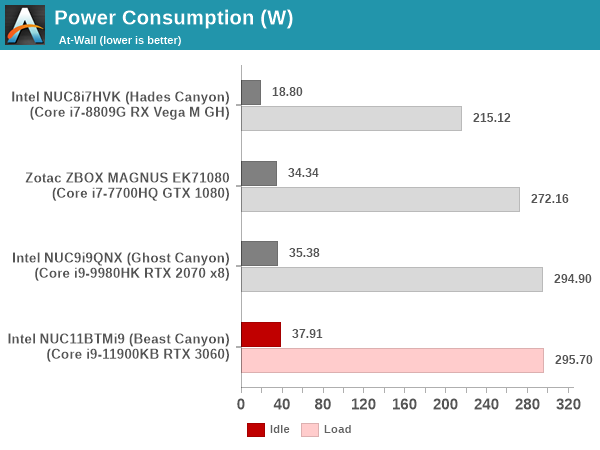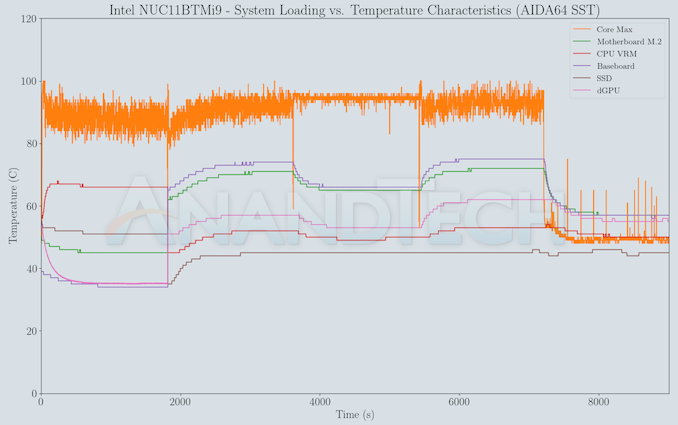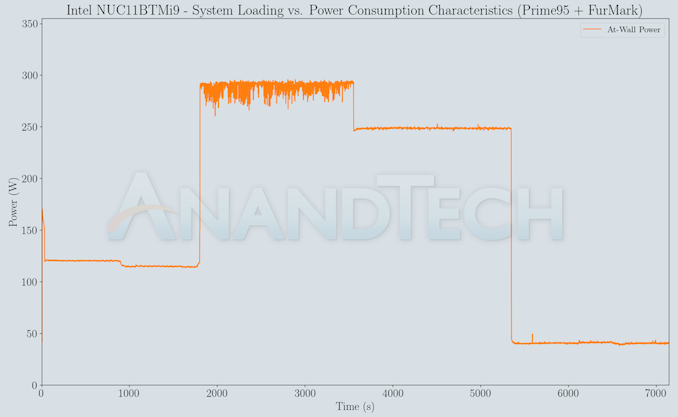Intel Beast Canyon NUC Review: Desktop Tiger Lake Debuts in SFF Gaming Powerhouse
by Ganesh T S on July 29, 2021 9:00 AM EST- Posted in
- Systems
- Intel
- NUC
- Tiger Lake
- NUC11
- Beast Canyon
Power Consumption and Thermal Performance
The power consumption at the wall was measured with a 4K display being driven through the HDMI port of the discrete GPU. In the graphs below, we compare the idle and load power of the Intel NUC11BTMi9 (Beast Canyon) with other similar PCs evaluated before. For load power consumption, we ran the AIDA64 System Stability Test with various stress components, as well as the artificial power virus test involving Prime95 and Furmark. The maximum sustained power consumption at the wall was recorded.

The numbers are very similar to the ones obtained for the Ghost Canyon NUC.
Our thermal stress routine starts with the system at idle, followed by four stages of different system loading profiles using the AIDA64 System Stability Test (each of 30 minutes duration). In the first stage, we stress the CPU, caches and RAM. In the second stage, we add the GPU to the above list. In the third stage, we stress the GPU standalone. In the final stage, we stress all the system components (including the disks). Beyond this, we leave the unit idle in order to determine how quickly the various temperatures in the system can come back to normal idling range. The various temperatures and power consumption number for the system during the above routine are presented in the graphs below.
While the CPU package manages to stay below the junction temperature during the system stability test, it does hover very close to the limits. This is likely due to the fans not taking effect soon enough, as the BIOS tries to maintain a balance between noise levels and cooling efficiency. It is likely that the production BIOS will need to sacrifice some noise levels for better thermals. Despite significant loading on the SSD, the thermal solution is good enough to keep the temperature below 75C.
A similar test routine is conducted with Prime95 running in maximum power consumption mode for 30 minutes, followed by the addition of a FurMark stress workload for another 30 minutes. After a cumulative run time of a hour, the Prime95 workload is removed, and FurMark allowed to proceed for another 30 minutes. The system is then left idle for another half an hour. The metrics tracked in the AIDA64 SST case are also tracked here.
The artificial power virus test significantly amps up the power consumption when both Prime95 and Furmark are simultaneously active. The GPU temperature is also a bit toasty and seems to suffer some after-effects of the Furmark loading. However, the core temperature quickly falls down to around 50C, thanks to the well-ventilated chassis and the three fans on the top panel.














84 Comments
View All Comments
dullard - Thursday, July 29, 2021 - link
Have you actually done the math on how infrequently ECC actually helps the typical user?So what if roughly once a year, I get a one bit change in my audio for a split second, or a single pixel changed on my video, or my photo needs to load twice from Facebook, etc. Most people just don't have anything that is valuable on their personal computers any more. Almost nothing most people do now on computers will care if a memory error occurs. Combine that with the very infrequent memory errors and it just isn't a problem.
Absolute worst case scenario: I have to restore one corrupted file from backup.
With servers, ECC certainly is needed. With certain financial and security applications, ECC is definitely needed. For people to repost spam on Facebook? Nope, ECC need not found.
willis936 - Thursday, July 29, 2021 - link
Once you start climbing up the bathtub curve it isn't one bit flip every year. It's dirty bits constantly written to disk. It's a real nightmare.Spunjji - Friday, July 30, 2021 - link
"constantly"Not really
willis936 - Friday, July 30, 2021 - link
Yes, it is. I just ditched a system that could no longer install an OS without error. Memory tests hung. It wasn't the modules. Dust had shorted some memory channel pins and either damaged the motherboard or CPU.There were bad blocks all over the disk. I ran fsck to get back the user's files but there is no telling if the data's any good.
Do you even know what a bathtub curve is?
mode_13h - Monday, August 2, 2021 - link
> Have you actually done the math on how infrequently ECC actually helps the typical user?If you have bad RAM, it can be a major source of system instability. I think this is the primary benefit of ECC.
I've wasted time debugging software problems, in the past, only to find out that the problem was specific to a given machine and that machine turned out to have bad RAM. Once the DIMM indicated by memtest was replaced, the bug stopped occurring.
So, for the sake of my time and sanity, I use ECC whenever possible. Even though bad RAM isn't that common, the premium for ECC is a small price to pay for the extra margin of safety.
When ECC isn't an option, I always do an initial overnight memtest run and try to use memory rated for a higher speed than what I plan to run it at.
dullard - Thursday, July 29, 2021 - link
And the more obvious retort, this is a "SFF Gaming Powerhouse", I asked why one would want ECC for it and you reply with "should be used only in game consoles or similar applications". Seems like you missed the point of the product.If there is another use case for this product that actually needs ECC, then I'm curious to know what that use case is.
willis936 - Thursday, July 29, 2021 - link
A powerful personal computer. NUCs are made to be personal computers. If they put a big CPU and GPU in it then it's going to handle workloads thrown at it. How does ECC not fit this use case?dullard - Friday, July 30, 2021 - link
SFF works best as portable gaming and home theater uses. Neither of which have any need for ECC.I'm not saying that some computers don't need ECC. It is just that desktop computers that need ECC usually aren't physical size limited, don't need to be portable, and/or don't need full size video cards. I'm just stumped as to any real use case that actually needs that particular combo. Every use case that I can think of where ECC helps (which is not really common for personal users) either doesn't need SFF or doesn't need a large video card. It sounds much more like a wish list than a real need.
Spunjji - Friday, July 30, 2021 - link
"It sounds much more like a wish list than a real need."Bingo, but some people's wish lists are backed up by some heavy post-hoc rationalization.
willis936 - Friday, July 30, 2021 - link
This thinking is painfully flawed.You don't *need* a computer of any kind. Why bother with a smartphone or a SFF desktop?